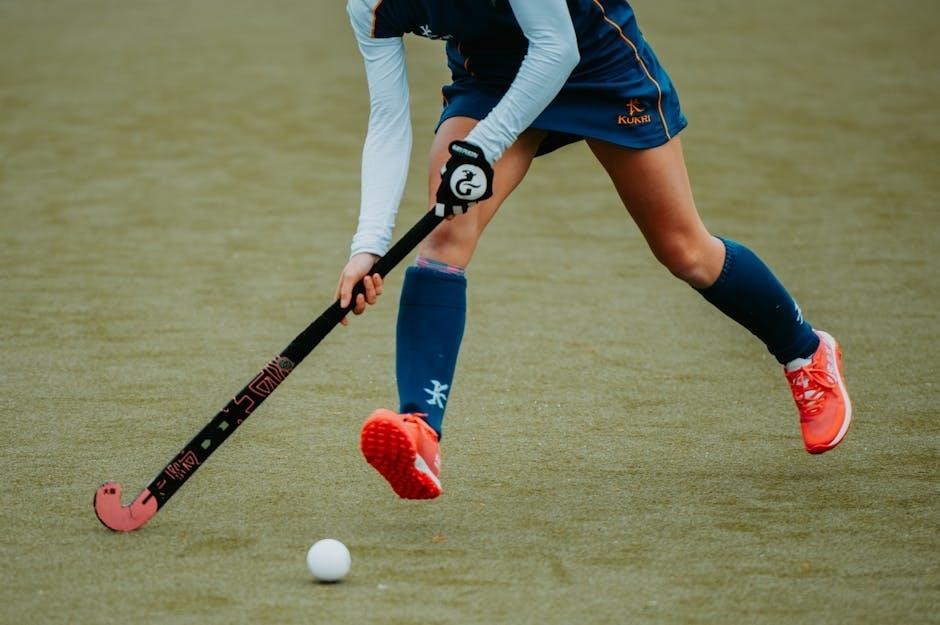Selecting the right field hockey stick size is crucial for performance, comfort, and control․ This guide helps players of all levels understand the key factors in choosing the ideal stick․
Importance of Choosing the Right Stick Size
Choosing the right field hockey stick size is essential for optimal performance, comfort, and control․ A properly fitted stick ensures better technique, reduces fatigue, and minimizes the risk of injury․ It also enhances accuracy and power during gameplay․ Whether you’re a beginner or an advanced player, the correct size tailored to your height and playing style significantly impacts your overall effectiveness on the field․ This guide helps you make an informed decision․
Overview of Field Hockey Stick Components
A field hockey stick consists of the handle, shaft, head, and toe․ The handle provides grip and control, while the shaft offers flexibility and power․ The head, with its curved design, aids in trapping and hitting the ball, and the toe determines the stick’s balance and ball control․ Understanding these components helps players choose a stick that aligns with their playing style and positional needs, ensuring both performance and durability;

How to Measure the Correct Field Hockey Stick Size
Stand upright and place the stick vertically beside you․ The top should reach your hip bone or just below your waist for optimal fit and control․
Standard Method for Measuring Stick Length
The standard method involves standing upright with feet shoulder-width apart․ Place the stick vertically beside you, ensuring the top reaches the hip bone or just below the waist․ This measurement provides a baseline, but personal preference and playing style may require adjustments․ Proper alignment ensures optimal control and maneuverability during gameplay․
How to Ensure Proper Fit and Comfort
To ensure proper fit and comfort, stand upright and hold the stick vertically beside you․ The top should reach your hip bone or just below your waist․ Adjustments may be needed for personal comfort and reach․ The stick’s length should allow for ease of handling while maintaining control․ Trying different sizes can help determine the ideal fit for your playing style and comfort level․
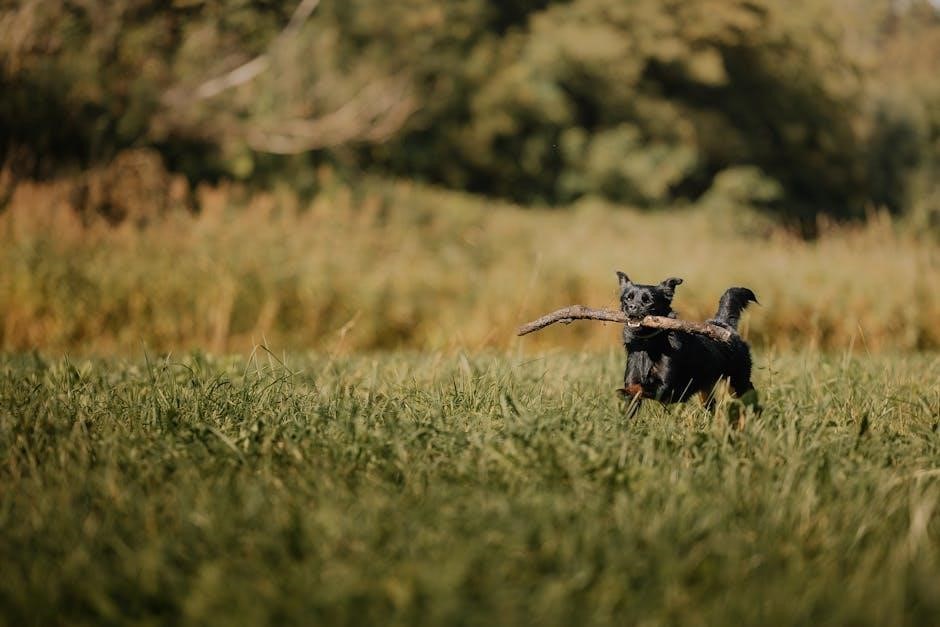
Field Hockey Stick Size Chart Based on Height
A field hockey stick size chart correlates player height with stick length, typically ranging from 28 to 37․5 inches․ Proper measurement ensures optimal performance and comfort․
Height and Stick Length Correlation
The height-to-stick length correlation is a fundamental principle in selecting field hockey sticks․ Generally, taller players require longer sticks, while shorter players benefit from shorter sticks․ The standard measurement places the stick’s top near the hip bone when standing upright․ This ensures optimal control, balance, and performance․ While height is a key factor, personal preference and playing style also influence the final choice․ Proper sizing enhances both comfort and effectiveness on the field․
Junior vs․ Senior Stick Length Recommendations
Junior players typically use shorter sticks, ranging from 28 to 32 inches, to facilitate better control and skill development․ Senior players, being taller and more experienced, often opt for longer sticks, between 35 and 37․5 inches, to maximize power and reach․ The choice is influenced by height, skill level, and comfort, ensuring the stick length aligns with the player’s physical growth and playing style․ Proper sizing is essential for optimal performance and safety․
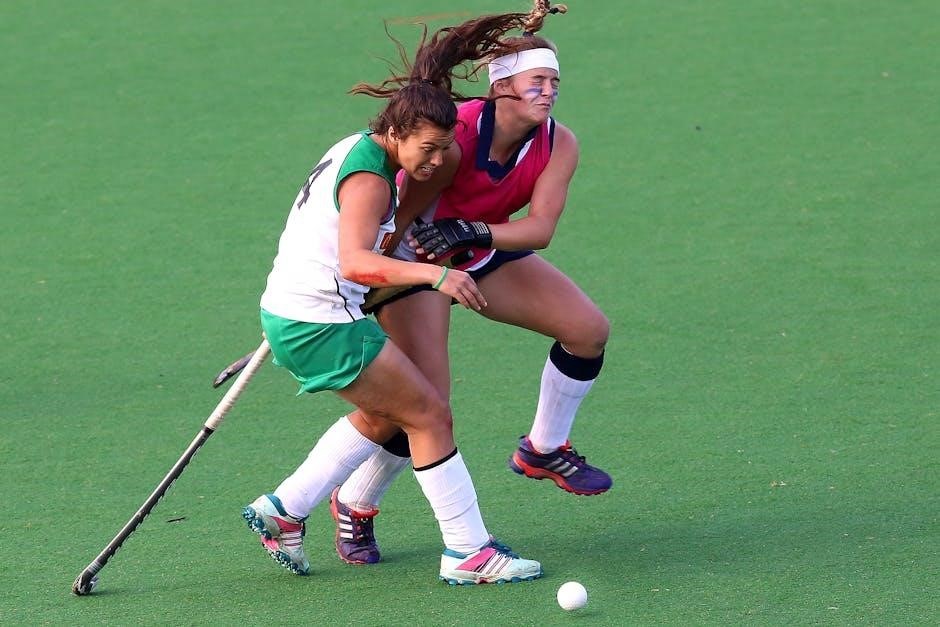
Factors Influencing Stick Size Beyond Height
Beyond height, skill level and playing position significantly influence stick size․ Players with higher skills may prefer longer sticks for power, while forwards opt for shorter ones for control․
Impact of Skill Level on Stick Size
Skill level significantly influences field hockey stick size․ Advanced players often prefer longer sticks for power and reach, while intermediate or beginner players may opt for shorter sticks․ Longer sticks allow skilled players to generate more speed and control during passes and hits․ Conversely, shorter sticks provide better maneuverability and easier handling, which is beneficial for developing players focusing on precision and technique․ Balancing stick length with skill level ensures optimal performance and comfort․
Position-Specific Stick Length Preferences
Position greatly influences stick length preferences․ Forwards often choose shorter sticks for agility and ball control, while midfielders opt for medium lengths to balance speed and reach; Defenders prefer longer sticks for stronger clears and intercepts․ Goalkeepers use extra-long sticks for better reach in defense․ Understanding position-specific needs helps players select the optimal stick length, enhancing their effectiveness and overall team performance․ This tailored approach ensures each role is equipped for success․
Understanding Stick Bow Size and Shape
The bow size and shape significantly impact performance, affecting ball control and hitting power․ This section explores how to choose the right bow for your style․
Importance of Bow Size in Performance
The bow size significantly impacts performance, affecting drag flicking, 3D skills, and stick handling․ A larger bow enables more power for aerials and drag flicks, while a smaller bow allows for precision and control․ Proper bow size is crucial as it tailors to individual playing styles, optimizing techniques and overall gameplay effectiveness․
Popular Bow Shapes for Different Playing Styles
Various bow shapes cater to distinct playing styles․ The traditional bow offers better ball control and passing precision, while the low bow enhances striking and shooting power․ Mid-bow balances control and power, ideal for versatile players․ The super-low bow emphasizes drag flicking and aerial skills, favored by specialists․ Each shape tailors to specific techniques, ensuring optimal performance for forwards, midfielders, and defenders alike in dynamic gameplay․

Field Hockey Stick Material and Composition
Field hockey sticks are made from materials like wood, fiberglass, and carbon fiber․ Composite sticks combine these for optimal weight, durability, and performance․
Common Materials Used in Stick Construction
Field hockey sticks are constructed from various materials, including wood, fiberglass, carbon fiber, and aramid․ Wood is traditional, offering excellent feel and control․ Fiberglass enhances durability and reduces weight․ Carbon fiber is lightweight and provides exceptional power․ Aramid adds strength and vibration reduction․ Some sticks combine materials like carbon fiber and Kevlar for added durability․ These compositions balance weight, strength, and performance, catering to different skill levels and playing styles․
How Material Affects Stick Weight and Durability
Material significantly impacts both the weight and durability of a field hockey stick․ Carbon fiber sticks are lightweight and durable, ideal for advanced players․ Fiberglass adds strength without increasing weight, making it a popular choice․ Wooden sticks offer a traditional feel but are heavier and less durable․ Composite materials, like carbon fiber and aramid blends, provide a balance of weight, strength, and longevity․ Higher carbon content reduces weight while enhancing power and responsiveness․
Personal Preference in Choosing Stick Length
Personal preference plays a key role in selecting stick length, as players may prioritize control, power, or comfort based on their unique style and position․
How to Determine the Ideal Stick Length for Your Playstyle
Evaluate your position, skill level, and playing style to choose the ideal stick length․ Forwards may prefer shorter sticks for better control, while midfielders and defenders might opt for longer ones․ Consider how the stick feels during gameplay and whether it enhances your ability to handle the ball effectively․ Experimenting with different lengths can help you find the perfect fit for your performance and comfort on the field․
Trying Out Different Stick Sizes Before Purchase
Testing various stick sizes ensures optimal performance and comfort․ Borrow sticks from teammates or try them at practice to gauge feel and control․ Pay attention to how each length affects your ability to handle, pass, and shoot․ This hands-on approach helps identify the perfect fit for your skills and style, preventing purchase regrets and enhancing your game experience․
Field Hockey Stick Sizing Chart by Brand
Brands like STX and Osaka provide detailed sizing charts, matching player height to stick length․ These guides help players choose sticks tailored to their needs and preferences․
STX Field Hockey Stick Sizing Guide
STX offers a detailed sizing chart correlating player height with stick length, ensuring optimal performance․ For instance, a player measuring 5’7″ typically uses a 36-inch stick․ The chart ranges from 28 to 37․5 inches, accommodating various heights and preferences․ STX also considers skill levels, providing shorter sticks for better control and longer ones for reach; This guide helps players select the perfect stick for their game․
Osaka Field Hockey Stick Size Recommendations
Osaka provides a structured guide for selecting the ideal stick based on height and skill level․ Their sizing chart recommends specific lengths for players of different heights, ensuring optimal performance․ For example, a player measuring 5’2″ is advised to use a 34-inch stick, while taller players may opt for longer options․ Osaka also considers playing style, offering tailored recommendations for forwards, midfielders, and defenders․ This approach ensures a personalized fit, enhancing both comfort and gameplay efficiency․
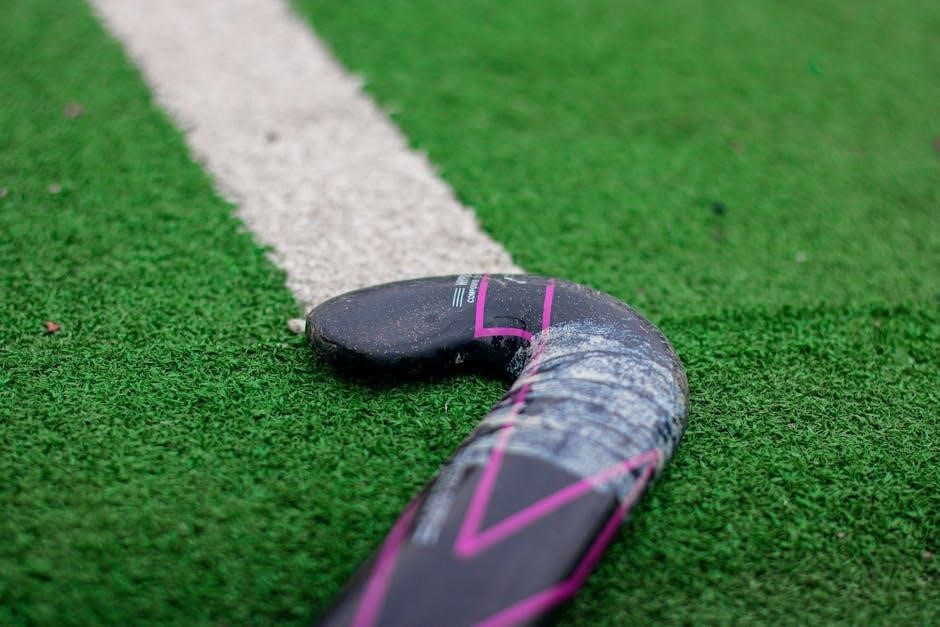
Stick Size for Youth and Growing Players
Youth players need sticks tailored to their height and playing style․ Sticks should reach the hip bone for proper fit, allowing for growth and skill development․
Choosing the Right Stick Size for Children
For children, the correct stick size is essential for skill development and comfort․ Sticks should reach the hip bone when standing flat-footed, allowing for growth․ Junior sticks are lighter and shorter, catering to younger players’ strength and control․ Parents should consider their child’s height, skill level, and playing style when selecting a stick․ Trying different sizes ensures the best fit, promoting proper technique and enjoyment of the game․
Progressing Stick Sizes as Skills Develop
As children grow and improve their skills, their stick size should adjust accordingly․ Junior players typically start with shorter, lighter sticks that allow for better control and technique development․ As they gain strength and confidence, they can gradually move to longer sticks, balancing reach and maneuverability․ Monitoring growth and skill progression ensures the stick remains suitable, promoting continued development and enjoyment of the sport․
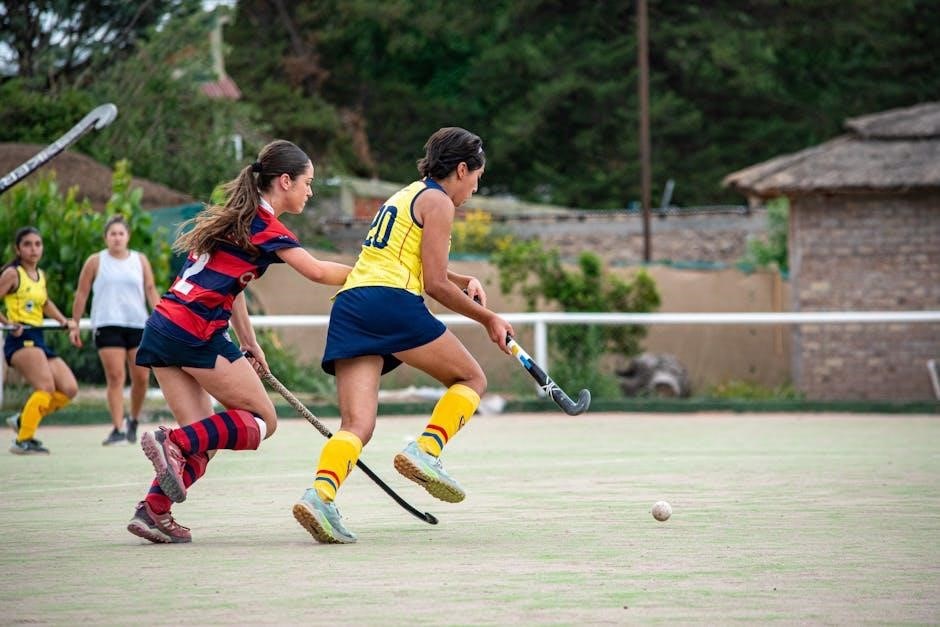
Advanced Considerations for Stick Size
Beyond basic height charts, advanced players consider skill level, position, and playing style․ Stick length and bow size must align with specialized techniques and field demands․
Stick Length for Specialized Skills Like Drag Flicking
For advanced techniques like drag flicking, stick length plays a critical role․ A slightly shorter stick, typically 1-2 inches below the standard recommendation, enhances control and precision․ This allows for better manipulation of the ball during flicks․ However, personal comfort and skill level should guide the final choice, as some players may adapt to longer sticks effectively․ Proper stick length ensures optimal performance in specialized skills․
Optimal Stick Size for 3D and Aerial Skills
For 3D and aerial skills, a slightly longer stick (36-37․5 inches) is often preferred, as it provides better reach and control for overhead passes and flicks․ The additional length allows for precise ball maneuvering while maintaining power․ However, personal preference and skill level play a significant role, as shorter sticks can also be effective for agile players․ Balancing stick length with technique ensures optimal performance in advanced aerial and 3D skills․
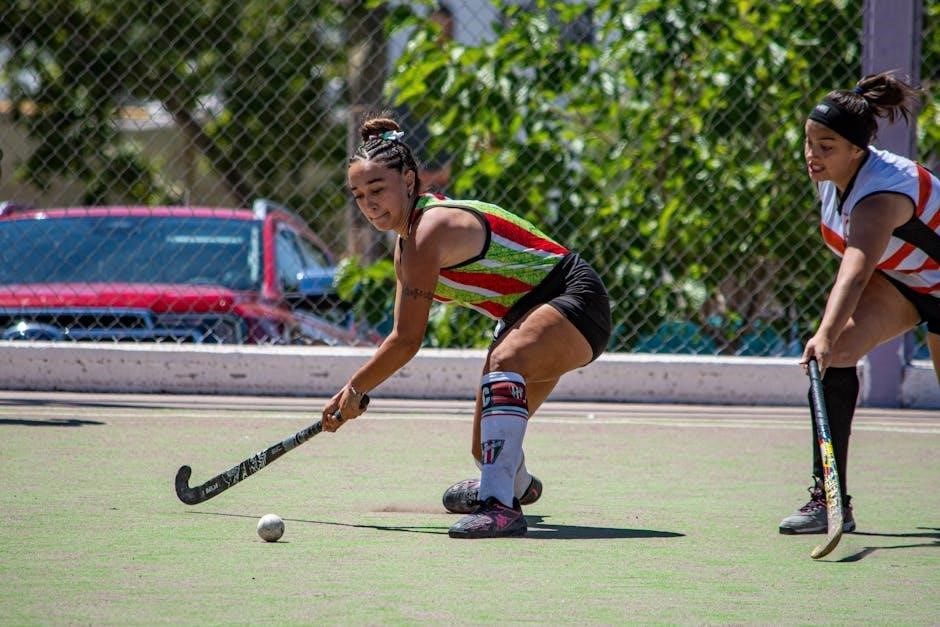
Common Mistakes to Avoid
A common mistake is overlooking personal comfort and skill level when selecting stick size, leading to poor performance and discomfort during play․
Overlooking Personal Comfort in Stick Size
Ignoring personal comfort when choosing a stick size can lead to poor posture, discomfort, and reduced performance․ A stick that is too long or too short forces players to adapt their stance, potentially causing fatigue or injury․ Proper fit ensures optimal control and maneuverability, directly impacting gameplay efficiency․ Always prioritize comfort and ergonomics to enhance overall hockey performance and enjoyment․
Ignoring Skill Level When Selecting Stick Size
Ignoring skill level when choosing a stick size can hinder performance and cause discomfort․ Skilled players may prefer longer sticks for reach but shorter ones for better control․ Beginners often benefit from a balanced stick length․ Failing to consider skill level can lead to poor technique and reduced effectiveness on the field․ Always match stick size to your skill level for optimal performance and comfort․
Maintaining Your Field Hockey Stick
Regularly clean and store your stick in a dry place to prevent damage․ Avoid extreme temperatures and ensure proper handling to extend its lifespan and performance․
How to Properly Store Your Stick
To maintain your field hockey stick, store it in a cool, dry place․ Avoid exposure to moisture and extreme temperatures․ Stand the stick upright or lay it flat, ensuring the head is protected․ Use a stick bag or cover to prevent damage․ Regularly inspect for wear and tear, and avoid leaning it against sharp objects․ Proper storage extends the stick’s lifespan and maintains its performance quality over time․
Caring for Your Stick to Ensure Longevity
Regularly clean your stick with a damp cloth to remove dirt and moisture․ Avoid using harsh chemicals, as they can damage the materials․ Store it in a dry environment and avoid exposure to extreme temperatures․ Inspect for wear and tear, and replace any damaged parts promptly․ Handle the stick with care to prevent dents or breaks․ Proper maintenance ensures optimal performance and extends the stick’s lifespan, keeping it in great condition for years․
Choosing the right field hockey stick size is essential for optimal performance and longevity․ Proper fit, comfort, and customization ensure a better playing experience and enhanced skills development․
The right stick size enhances performance, comfort, and control․ Key factors include height, position, skill level, and personal preference․ Proper fit ensures optimal gameplay․
- Stick length typically correlates with player height, reaching the hip bone․
- Position and skill level influence stick length preferences․
- Material and bow shape affect performance and durability․
- Trying sticks before purchase ensures comfort and suitability․
Final Tips for Optimizing Your Field Hockey Performance
To maximize your performance, ensure your stick fits your height, position, and skill level; Experiment with different sizes and materials to find your ideal match․ Proper maintenance extends stick longevity, while a well-chosen bow enhances control․ Confidence in your equipment translates to better gameplay․ Always prioritize comfort and adapt your stick choice to your evolving playstyle for optimal results on the field․
